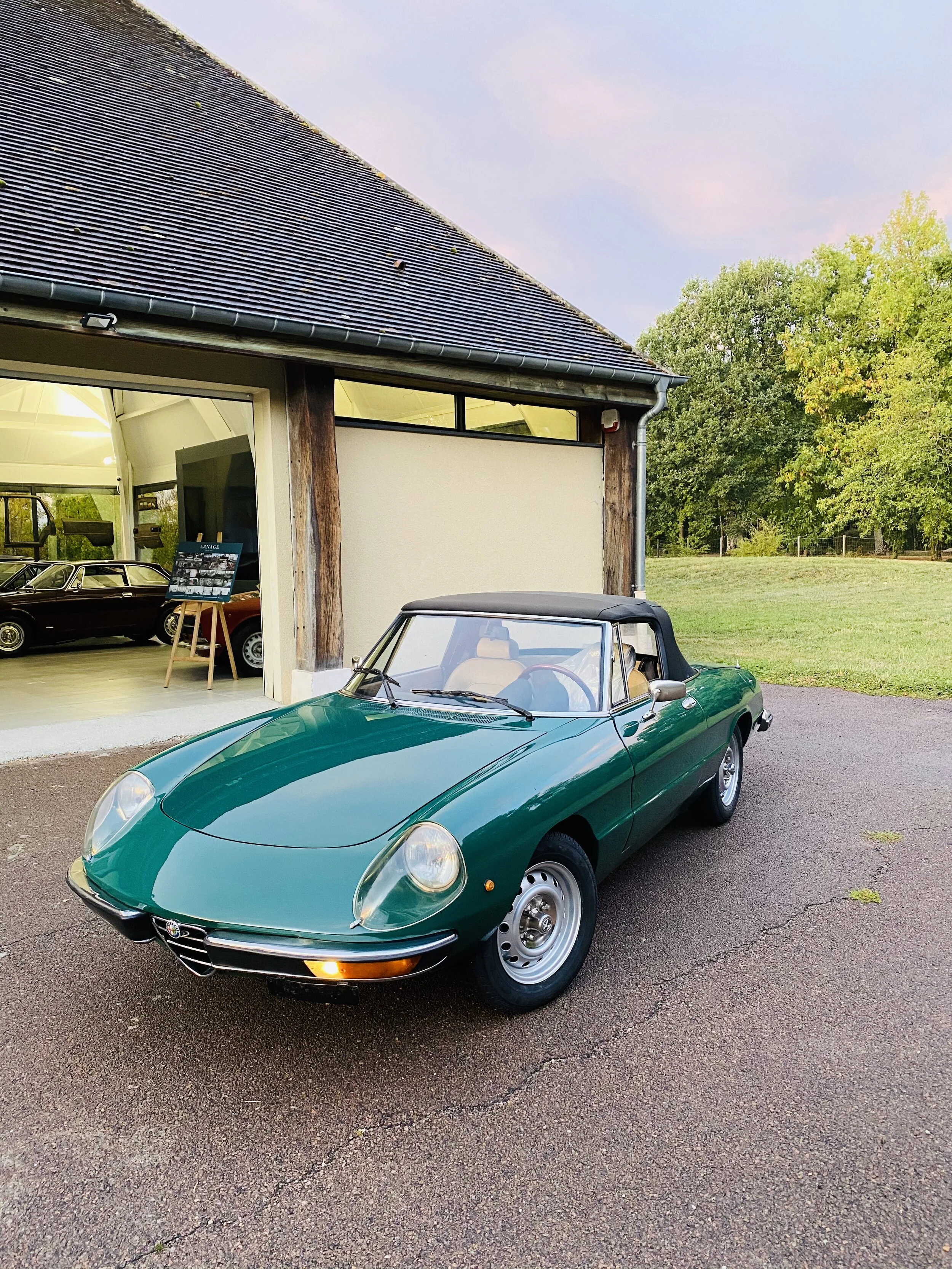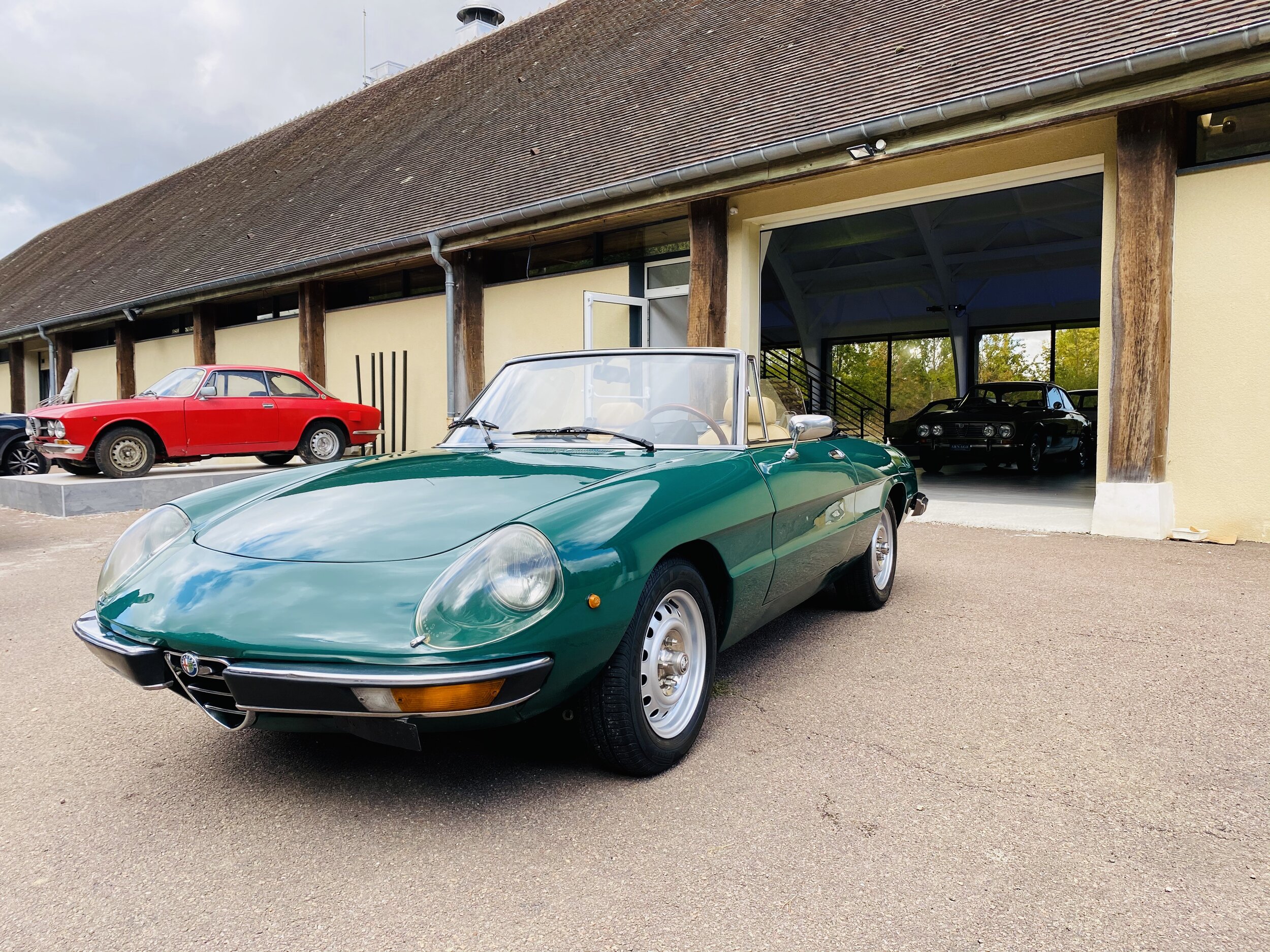Alfa Romeo Spider 2000, 1978, verde inglese
The Alfa Romeo Spider (105/115 series) is a two-seater, front engine, rear drive roadster manufactured and marketed by Alfa Romeo from 1966 to 1994 in four distinct generations, or Series, each with modifications ranging from modest to extensive. As successor to the Giulia Spider, the Spider remained in production for almost three decades. The first three Series were assembled by Pininfarina in Grugliasco and the fourth Series in San Giorgio Canavese. The last Spider was manufactured in April 1993. In 1962 Alfa Romeo introduced the new 105 Series Giulia, which first complemented and then replaced the 101-series Giulietta. The sport variants of the Giulietta remained on sale for several more years, upgraded to the Giulia's 1.6-litre engine and rebadged Giulia, until analogous variants of the new models were ready. Thus the Giulietta-based Giulia Spider 1600 and Giulia Spider Veloce were produced from 1962 to 1965 and from 1963 to 1965 respectively.The Alfa Romeo Spider was based on Giulia mechanicals, including its Alfa Romeo twin cam inline-four, independent front and solid axle rear suspension. Following the evolution the other Giulia sport variants, the Spider was powered by a 1.6 L engine, later received a 1750 cc, then a 1300 cc, and finally a 2000 cc engine. Unlike any other Giulia derivative, it was upgraded and continued to sell through four decades, into the 1990s. As for its predecessor the Giulietta Spider, the Italian firm of Pininfarina was responsible for the design, manufacturing of the body, as well as final assembly. The 1600 Spider was the last project in which founder Battista Pininfarina was involved.
The original 1966 Spider shape was the result of a number of Pininfarina design studies, concept cars showing traits incorporated in the final production design.The first one was the Alfa Romeo Superflow, a concept car built upon the chassis of a retired 6C 3000 CM racing car and first shown at the 1956 Turin Motor Show. Despite being an aerodynamic coupé with prominent fins on the rear, and a futuristic all-plexiglas greenhouse and front wings, the Superflow already showed the overall body shape of the future Spider and the scallops on the sides. In the following years the Superflow was updated three times into three more different concept cars.It did without the rear fins of the Superflow and Superflow II, showing for the first time the rounded cuttlebone-shaped tail and tail light configuration of the Spider. Last of the Spider's forerunner was the Giulietta Sprint Speciale-based Alfa Romeo Giulietta SS Spider Aerodinamica, which premiered at the 1961 Turin Motor Show.
Series 1 (1966–1969)
The Spider was launched at the 36th Geneva Motor Show in March 1966, and together with the Giulia Sprint GT Veloce tested by the press at an event organised in Gardone Riviera.To choose a name for the spider Alfa Romeo announced a write-in competition, offering an example of the new car as a prize. Over 100 thousand ballots were sent in, the great majority from Italy; the winner was Guidobaldo Trionfi from Brescia, who proposed the name "Duetto" (duet). However it could not be officially adopted due to trademark issues, and the car was named simply Alfa Romeo Spider 1600. The Spider's 1,570 cc twin cam engine had dual Weber two-barrel side-draft carburetors, and produced 109 PS DIN (80 kW; 108 hp; or 129 PS SAE). Sparsely fitted inside but including five speed manual transmission, disc brakes 15" wheels fitted with Pirelli Cinturato 155HR15 CA67 tyres. The price on launch in Italy was 2,195,000 lire. In the US the car sold for $3,950 (compared to $3,991 for a Lotus Elan and $2,607 for an MGB).In the UK the car's price was close to a Jaguar E-Type.
Series 2 (1970–1982/83)
In 1970 the first significant change to the exterior styling was introduced on the 1750 Spider Veloce, with the original's distinctive elongated round tail revised to a Kamm tail, improving luggage space. Numerous other small changes took place both inside and out, such as a slightly different grille, new door handles, a more raked windscreen, top-hinged pedals and improved interior trim. 1971 saw the Spider Veloce receive a new, larger powerplant—a 1962 cc, 132 hp (98 kW) unit—and consequently the name was changed from 1750 Spider Veloce to 2000 Spider Veloce. The 1600 Spider restarted production a year later as the Spider 1600 Junior, and was visually identical to the 1300. 4,557 of the 1300 Junior were made and 4,848 of the 1600 Junior. 16,320 Spider Veloce 2000 were made and 22,059 of the Spider Veloce 2000 Iniezione (US version). Of the 1750 Spider Veloce, 4,027 were made.
According to Alfa Romeo Storico, our car was produced on November 1978, delivered to The Netherlands, in an unique Verde Ingress body color.
€ PAO




